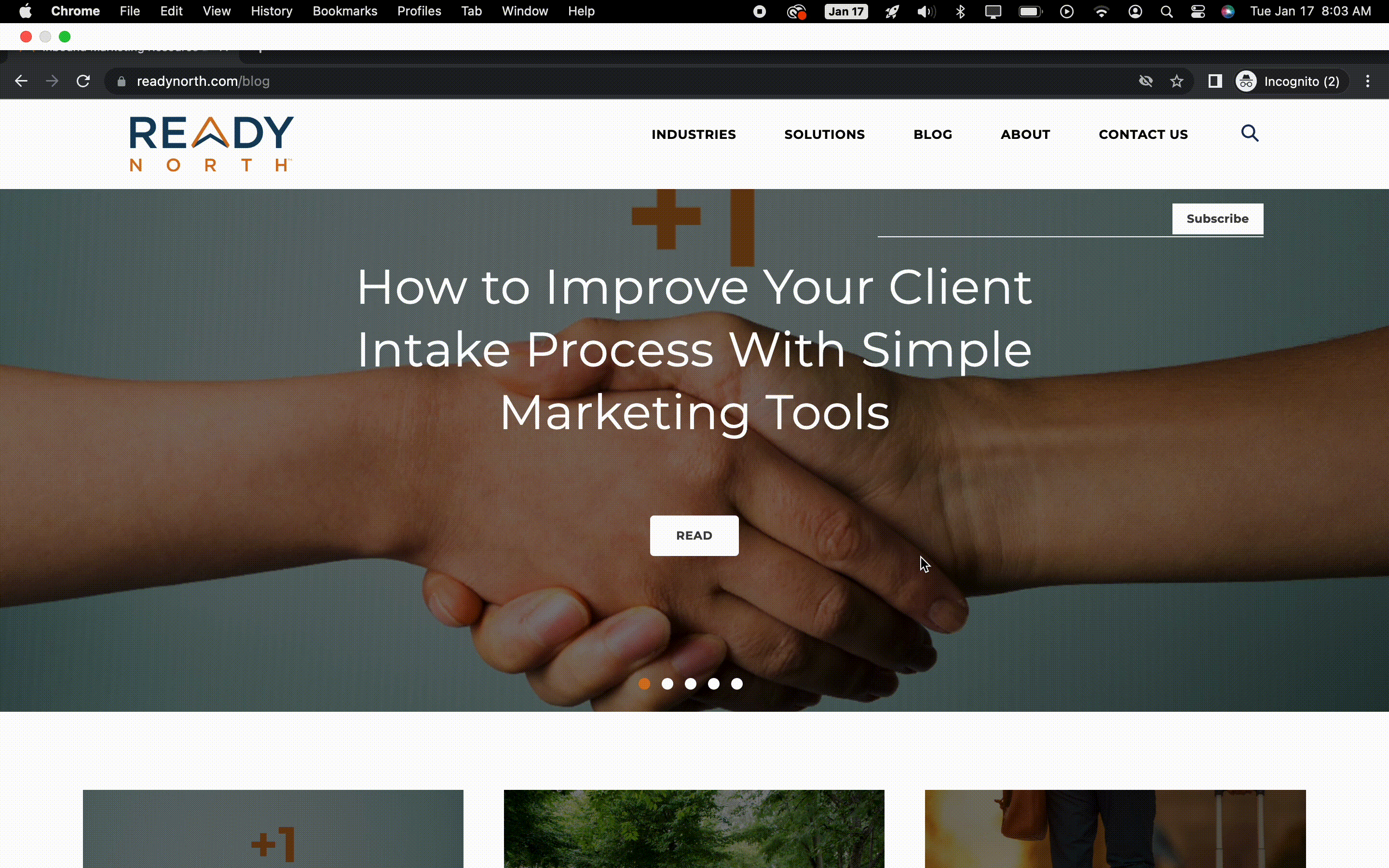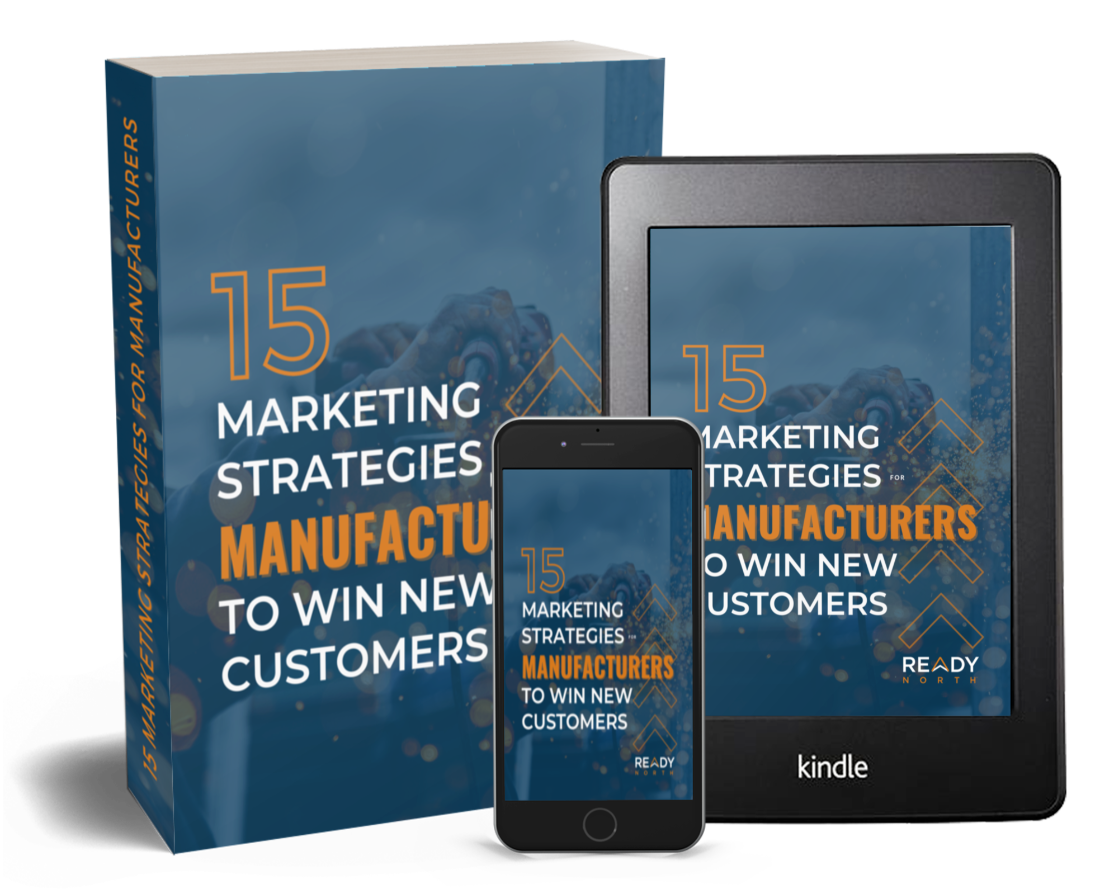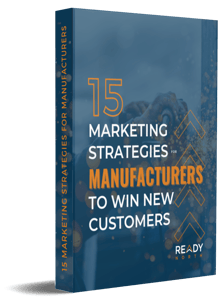The Manufacturer's Marketing Guide to Attracting New Customers
Manufacturing is a critical component of the global economy.
Representing 16% of the global GDP as of 2020, manufacturing is the driving force behind modernization, economic growth, and innovation across industries.
However, consumer behavior has evolved significantly following the Covid-19 pandemic, bringing new challenges to manufacturers’ doors.
It’s more challenging to reach and engage consumers, forcing manufacturers to innovate like never before to meet shifting demands.
Technology is changing, bringing both positive and negative implications with it. Automation has enabled manufacturers to store, sort, process, and deliver products to customers more quickly and efficiently. But, technology has also made competition more fierce, making it harder than ever to grow a profitable manufacturing business amongst the local and global challenges.
To top it off, supply chains remain volatile and in constant disruption. Materials shortages continue to cause price increases for customers. And, it has not gotten any easier to find and retain a consistent workforce.
Nonetheless, many of these challenges are out of your hands. However, you do control how you position and promote your company to prospective customers. If you do it genuinely and intelligently, you can begin filling your pipeline with qualified leads today.
Here is where our guide comes in. Word of mouth can no longer cut it as your primary marketing technique. Lucky for you, the manufacturing sector is ripe with opportunities to attract and convert new customers with the right marketing plan. We know this to be true because we’ve helped our manufacturing clients do exactly that with the strategies included in this guide. Let’s dive in.
Table of Contents
- What is inbound marketing?
- Chapter 1: Planning Strategies
- Create a content hub strategy and editorial calendar.
- Conduct a search engine optimization (SEO) audit and strategy.
- Develop complementary lead scoring and lead nurturing strategies.
- Design a profitable digital paid strategy.
- Build out an optimization strategy for your marketing automation platform.
- Drive immediate change with a conversion rate optimization strategy.
- Upskill your team.
- Chapter 2: Production Strategies
- Chapter 3: Promotion Strategies
- Designing a Data-Driven Marketing Strategy
What is inbound marketing?
Most of the strategies included in this guide are considered elements of inbound marketing.
First coined by HubSpot’s co-founders Brian Halligan and Dharmesh Shah, inbound marketing is the business methodology of attracting customers by creating valuable content and experiences tailored to them.
Conversely, outbound marketing refers to the practice of proactively reaching out to customers to get them interested in your product and/or service.
While each has its pros and cons, the strategies we recommend in this guide align with inbound marketing. Learn how to grow your business by building meaningful relationships with your customers and prospects at any stage of their journey with you.
You’ll also notice that many of these strategies fall into the bucket of content marketing, which is the process of planning, developing, distributing, and sharing content across your marketing channels (social media, blogs, websites, etc.). This type of marketing is extremely important for educating your prospects about the products and services you offer in a way that resonates with them organically and does not feel pushy.
Does inbound marketing work for manufacturers?
Consider these facts:
- Inbound leads cost 62% less than outbound/traditional leads
- More than 70% of marketers are actively investing in inbound marketing
- Roughly 60% of those marketers say inbound is “very important” or “extremely important”
- B2B brands find inbound marketing and SEO to be more effective than B2C brands
- B2B brands have seen better ROI from inbound marketing and SEO than B2C brands
It’s safe to say that inbound marketing is a more time- and cost-effective way for companies to attract new prospects to their company at scale.
How does it apply to manufacturers?
Check out this case study of how a 100-year-old manufacturing company leveraged inbound marketing to continue growing in its competitive marketplace.
Are you ready to explore the specific planning, production, and promotion strategies you can use to win new manufacturing customers? Let’s dive in.
Chapter 1: Planning Strategies for Manufacturers
For manufacturers looking for the foundational strategies necessary to build a strong manufacturing engine, this section of the guide will be your toolbox for creating a custom-tailored marketing plan designed to meet your unique growth objectives. The foundational strategies listed below can help you take a hard look at your current marketing assets and strategy so that you can determine the smartest path forward.
1. Create a content hub strategy and editorial calendar.
To build trust with your audiences, authority in your industry, and the organic strength of your website, you must create valuable, resource-driven content that resonates with your target personas before they even know that your company exists. This way, once a prospect is ready to pull the trigger on a purchase or new partnership, they select your company.
A content hub looks at the historical performance of existing content, a market analysis, buyer personas (semi-fictional representations of your ideal customers based on data and research), internal team interviews, keyword targeting, and industry trends to develop topics that demonstrate a strong understanding of your audiences’ challenges, needs, and questions at each stage of the buyer’s journey.
>> ⚙️Bonus Resource: How to Create Detailed Buyer Personas for Your Business
The result is an editorial calendar with at least 50 content topic/title ideas designed to drive growth at the top of your sales funnel while supporting lead generation (the process of attracting prospects to your business and increasing their interest through nurturing with the end goal of converting them into a customer down the line) and sales. There should be a healthy mix of content that is original, curated, and provided by guest authors.
Once your content hub and editorial calendar are developed, your team can get to work drafting and publishing valuable content on a regular cadence—boosting search engine optimization credibility (how relevant your website content is to a user’s search on Google) along the way.
2. Conduct a search engine optimization (SEO) audit and strategy.
SEO is critical to ensure your website is on the first or second search engine results pages (SERP) when a user searches terms relevant to your business. Consider the last thing you searched on Google—did you venture past the first page of results? Your prospective customer may not either.
An SEO audit dives deep into your website’s SEO health by examining current keyword rankings, content data points, user experience, and potential issues. Free tools you can use to conduct an SEO audit include:
- Our website grader to score your site’s SEO power
- Google Analytics for insights into your website’s performance
- Google Search Console to see how your site is indexed and appears in search results
Once audited, we recommend developing an SEO strategy with specific action items outlined to better optimize your website content for search and drive more organic traffic to your site. Solutions will include more than just updates to the keywords you’re using.
3. Develop complementary lead scoring and lead nurturing strategies.
These two strategies can work in tandem to immediately flag the contacts ready to talk to your sales team and take care of people who are interested in your brand but may not be sales-qualified yet.
Lead scoring is the process of assigning numerical values based on demographics and actions. Demographics might include a contact's industry, job title, company size, or growth objectives. Actions could include what website pages they visit, what marketing emails they open, or what calls-to-actions they click. You will use these indicators to classify, qualify, and prioritize leads for each of your buyer personas based on your ICP (ideal customer profile). In return, your scoring system will help you:
- Better assign leads to the most appropriate sales representative.
- Prioritize follow-ups to the leads with the greatest conversion potential conducted first.
- Set up lead nurturing to target specific, non-sales-qualified buyer personas and educate them about your company.
Think of lead nurturing as an upgrade to your lead scoring strategy. Lead nurturing is the process of developing and reinforcing relationships with prospective customers at every stage of the buyer’s journey through automated email workflows. Therefore, the goal of a lead nurturing strategy is to highlight segmenting opportunities and data gaps to lay the framework required to generate quality sales opportunities for new and returning customers. Through this process, you will build thought leadership, shorten the sales cycle, and bridge marketing and sales efforts.
You can develop your own lead scoring system in four simple steps using this guide and learn more about how to automate lead qualification with predictive scoring here.
4. Design a profitable digital paid strategy.
Paid advertising is a great way to ensure your targeted audiences are seeing your brand versus waiting for them to find you organically. While not implicitly an inbound strategy, paid advertising can be very effective in quickly building your pipeline if you have room in your budget.
A digital paid strategy aims to set a deliberate campaign framework that provides you with the most bang for your buck. To do this, we recommend setting a campaign objective first and then aligning your buyer personas, conversion opportunities (such as a newsletter subscription form or landing page for an ebook), and insights on your audiences and keywords to that goal.
From there, you’ll want to research which platforms make the most sense based on where your audience is and how much you’re willing to pay per click. Your result could be a mix of social media channels, such as Facebook and LinkedIn, or exclusively Google Search and Google Display ads.
If you’re looking for more specifics on how to get started, check out this free guide to PPC marketing.
5. Build out an optimization strategy for your marketing automation platform.
Manufacturers aiming to scale their marketing efforts will find it challenging to do so without dependable marketing automation software. In the face of today’s industry and economic challenges, efficiency is at the heart of any operation—so why would you accept inefficient marketing tactics?
If you already have a marketing automation tool, consider building an optimization strategy to guarantee that you and your teams take full advantage of its features. Suppose you’re not using marketing automation yet to boost efficiency, increase conversion rates, and better align your marketing and sales teams. In that case, you can learn more about our favorite CRM and automation tool here.
As part of an optimization strategy, you’ll want to take a hard look at the functionality of your marketing automation software—perhaps even scheduling a training session with your provider. The goal is to get acquainted with your portal and set it up according to your needs, goals, and preferences. Some of the most commonly underutilized features we see in our clients’ platforms include:
- Custom company and contact properties
- Campaign setup and reporting
- Email marketing features
- List management
- Reporting dashboards
- CTAs and pop-up forms
- Workflows
- Integrations with ERPs or other company platforms
Once the strategy is outlined, get started activating. If you’re unsure of the technical next steps needed for a task, check out your software’s support center. HubSpot’s comprehensive Help Center, for example, includes a knowledge base with hundreds of how-to articles, an academy with video certifications and training, a community forum, a customer blog, and more to answer any questions you may have.
The right platform can take your small business to the next level with automation, lead nurturing, integrations, performance reporting, and more. In fact, manufacturers with marketing automation software and CRM can achieve a 163% increase in inbound leads, a 40% increase in website visitors, a 65% improvement in deal close rate, and a 196% increase in won deals.
What manufacturer wouldn’t want that?
If you think your company could benefit from a new or updated marketing automation setup, we recommend researching and comparing marketing automation software using an unbiased site such as G2 Crowd.
>> ⚙️ Related Reading: How Allied Wire and Cable Grew Marketing Revenue by 9x with HubSpot CRM
6. Drive immediate change with a conversion rate optimization strategy.
If you want an immediate return on your new marketing initiatives, conversion rate optimization (CRO) is the strategy for you.
CRO is the process of reviewing your current website, databases, and other existing assets for opportunities to convert current traffic and prospects into qualified leads. Conversations act as checkpoints for contacts to progress through lifecycle stages when deployed optimally across a website. This way, you can get the most out of your active offerings while developing new and forward-looking marketing tactics.
To start, we recommend calculating your current conversion rate:

To see how your rate stacks up, Ruler Analytics reports the average conversion rates for Industrial and B2B (business-to-business) as 7.4% and 5.9%, respectively.
To set a conversion rate optimization strategy in motion, we recommend you audit your assets and develop a list of uniquely specific recommendations for your business and goals. While organizations can look to best practices, continually test theories, and evolve, CRO must be completely customized to an individual website and brand to be successful. The best places to start your audit include your homepage, pricing page, landing pages, and blog.
Once you’re ready to implement your CRO strategy, we recommend using the tips in strategy #13 to increase conversion points with CTAs and pop-up forms.
7. Upskill your team.
One of the most overlooked ways to maximize ROI and accelerate new customer acquisition is by upskilling your team. The cost of training a current team member is much lower than hiring a new employee and starting from scratch.
We recommend you audit your team’s strengths and weaknesses to identify the gaps in skill sets. This could range from entire business concepts, such as Account Based Marketing (ABM), to specific technology or tools.
Next, research relevant training materials and opportunities such as certifications, online courses, conferences, books, and webinars. Meet with your team to develop a professional development plan and gain their buy-in. You may even want to offer a reward program to incentivize learning.
Be sure to support your team through their training and discuss continuous professional development plans. Learn how to create a company-wide program to future-proof your team here.
Chapter 2: Production Strategies for Manufacturers
Now that you have some planning ideas in mind, it’s time to start producing the marketing goods that bring in new customers. Everything we cover in this section of the guide will be focused on creating content that unlocks brand potential, creates value for your audiences, and builds strong momentum for your pipeline. Let’s get started!
8. Start blogging.
One of the easiest ways to win new customers is by drafting relevant and useful content for your prospective audiences. According to They Ask, You Answer, 70% of the buying decision is made before a prospect talks to the company. If you treat each new customer like a salesperson, dedicated to learning everything there is to know about your business and its products and services, you’ll arm them with the knowledge they need to determine whether you’re a good fit for them.
If you already have a blog, we recommend looking at the historical performance of your blog posts to help identify topics that resonate with your audiences. If nothing sticks out—that’s ok; there are numerous other routes to identify what you should be talking about.
For those starting fresh with a new blog, we’d recommend a few tactics to drum up blog content ideas, including:
- Complete the exercise of creating a content hub strategy and editorial calendar (strategy #1).
- Use Google Search to narrow in on commonly searched phrases surrounding your industry, products, and services.
- Host a brainstorming session between your marketing and sales teams. Be sure to ask questions such as:
- Which of our products/services have the greatest revenue opportunity?
- What are the top questions asked by prospects in the sales process?
- What do prospects see as a negative about our products/services (too expensive, not comprehensive enough, etc.)?
- What are the reasons a prospect does not decide to do business with us?
- What does our competition say is a negative about what we sell?
- How can we address each of these to turn it into an advantage?
With these new insights, you should have a handful of blog topic ideas to start with. As you begin drafting, be sure that your posts are aimed at arming your prospects and customers with truly valuable information—not a promotion for your business. This is key to building trust with your audiences upfront and paving the way for an honest and transparent business relationship.
>> ⚙️ Related Resource: 40+ Blogs Marketers Should Be Following
9. Design a lead generation offer.
A lead generation offer is a piece of content your company offers to visitors in exchange for their personal information (like an email address). For your lead gen offer to be successful, it has to be deemed worthy enough by the visitor to offer their information. Typically, lead gen content is gated behind a landing page where visitors complete a form. Once submitted, the content offer is delivered to the visitor (now a lead!) directly in the thank you message, a redirected webpage, or an email.
When designing a lead gen offer, consider how the content will be formatted, gated, delivered, and promoted.
A lead gen offer can take numerous formats, including:
- Pillar page (check out these 7 examples)
- Ebook
- White paper (long- and short-form)
- Case study
- Tutorial video
- Infographic
- Interactive content experiences such as logic-based assessments and calculators
If you’re ready to create your own lead generation offer, we recommend checking out HubSpot’s Beginner's Guide to Generating Business Leads the Inbound Way. For more ways to promote your new lead gen content, jump to the next section.
Chapter 3: Promotion Strategies for Manufacturers
No marketing plan is complete without strategic promotional activities. In fact, a pillar of successful inbound marketing is the 80/20 rule, meaning 80% of your time and efforts should be spent on promotion, and the remaining 20% should be spent creating content to promote.
Promoting quality content will help you target and reach your ideal customer prospects and delight your existing contacts with personalized and relevant offers. Here are the top four ways to put the 80/20 rule into action.
10. Leverage social media marketing.
In today’s day and age, the importance of social media cannot be understated.
According to Pew Research Center, 72% of adults in the United States use at least one social media site, and nearly 50% of that population check those social media sites daily.
What’s more, according to CoSchedule, 78% of salespeople who leveraged social media for marketing efforts are outselling their peers who aren’t.
Not sure if social media is worth your time? Your competitors disagree. Within the manufacturing industry, 85% of companies already use social media tactics as part of their content marketing strategy.
If your manufacturing business is not on social media, it’s missing a massive opportunity to increase your brand awareness, build thought leadership within your industry, generate more traffic to your website, and promote your products and services.
To get started, we recommend auditing your current social media presence. Consider the following questions:
- Which social media platforms are your prospects using?
- Do you have accounts on those particular platforms?
- What has performed well on your channels in the past? What has not?
>> ⚙️ Related Resource: Social Media Checkup
From there, you should have enough insights to build out a simple social media strategy that aligns with your business objectives. You’ll want to keep these resources in mind:
- A Guide to Growing Your Small Business on Social Media
- 4 Rules to Creating Social Media Content That Cuts Through the Noise
- 4 Simple Ways to Build Your Brand's Social Media Fandom
- 4 Lessons Learned From the Most Agile Brands on Social Media
The content you're creating from the above steps needs promoting so that you can get grab the attention of current and potential followers. Consider sharing a 50/50 mix of owned content and trusted third-party resources with custom commentary to help build up your thought leadership.
11. Launch an email newsletter.
If you’ve got content to share (like the brilliant blog post topics you brainstormed above), an email newsletter is perfect for getting it in front of your target audiences.
Email newsletters are a dime a dozen—just check your inbox and spam folder—but when executed properly, they can be a pivotal tool for lead generation and nurturing.
To get started, you may need to research an email marketing platform that suits your needs (think: number of contacts, number of sends, reporting features). Tools like Constant Contact and Mailchimp specialize in email marketing and newsletters, often with integrations available for your CRM. HubSpot’s Marketing Hub also offers newsletter capabilities that connect email engagement insights to your CRM and provide advanced personalization features.
With a platform in mind, you’re only a few steps away from hitting send on your first newsletter. You’ll want to:
- Design an email newsletter template that’s visually appealing and encourages engagement.
- Consider sending frequency, date, and time.
- Create a simple newsletter sign-up page or pop-up on your website to start building your subscriber base.
- Confirm all contacts on your distribution list have opted into receiving marketing communications from your business.
Once your newsletter is launched, don’t forget to monitor its performance and adjust accordingly. Here are some tips for saving time on each send and how to grow your list of subscribers.
12. Incorporate video marketing.
Video marketing has become increasingly critical to a successful sales process. According to HubSpot, as of 2022, audiences spend an average of 19 hours a week watching videos online—meaning video requires a spot in every marketer’s toolbox. Video can be used to:
- Boost SEO
- Improve conversions
- Encourage social sharing
- Engage mobile users
Above all, in the case of inbound marketing for manufacturers, video marketing is vital to educating and building trust with your audiences. Don’t believe us? Here is Marcus Sheridan, co-owner of inbound marketing training company IMPACT, explaining why video marketing is so important to buyers and businesses:
Now that you have a firm grasp on the “why” of video marketing for manufacturers, we’ll dive into the how.
If you have a videographer or video team (or even someone handy with their cell phone camera!), we recommend they read part IV (chapters 38-50) of the book They Ask, You Answer. In less than 65 pages, they will have a basic understanding of how video marketing should complement the sales process and seven types of videos to get started with to immediately impact your sales and conversion rates.
If you aren’t lucky enough to have a videographer on staff, consider partnering with a marketing agency to craft a video strategy and content that fits your business.
Additionally, here are three easy ways manufacturers can dive head-first into video.
- Explore creating mobile-first videos because more than half of YouTube viewers watch on mobile devices.
- Integrate video into your social strategy by filming something using the high-definition camera on your smartphone and uploading it straight to your social channels as a standard post, Instagram Reel, TikTok video, and more.
- Swap written content for video when possible because content with visuals gets 94% more total views than written text alone. Product overviews and how-to videos are a great place to start.
Once you’ve taken the plunge into video marketing, use these tips to level up your creative content.
13. Increase conversion points with CTAs and pop-up forms.
One of the quickest, most effective ways to generate new business leads is to provide visitors to your website with more opportunities to convert. Adding calls-to-action (CTAs) and pop-up forms to your website is the best method.
A CTA is a button or visual image that prompts visitors to take action, such as signing up for your newsletter, downloading an ebook, or simply filling out a contact form. Because the CTA has to inspire action, it should be visually appealing and easy to locate. Many companies choose to use a bright but complementary color for their CTA buttons so they stand out. Below are several examples of CTAs you could implement on your site today.
Simple Button
Visual Image Button
On the other hand, a pop-up is an on-site form that manufacturers can use to seamlessly convert anonymous website visitors into leads. They can be used on any website, blog post, or landing page, customized to match your branding and target specific audiences. The video below shows a pop-up form for a blog subscription in action.

Pretty snazzy, right? Plus, with a solution like HubSpot, you can create Smart CTAs that display a customized button to your different visitors based on data stored on their HubSpot contact record, such as their lifecycle stage, or based on information known about their device type, country, referral source, or preferred language. You can also get insights into the performance of these pop-ups and forms, including the number of views, conversion rates, and more.
14. Activate a paid advertising campaign.
If your marketing budget allows, you can win new customers with a pay-per-click (PPC) advertising campaign—a process by which you can target specific audiences and pay each time they click on your ad.
When launching an ad campaign, you’ll want to consider the following elements:
- Advertising platforms (such as Google, Facebook, LinkedIn, etc.)
- Budget
- Potential market size
- Targeting options
- Ad creative and copy
- Performance management and adjustments
According to HubSpot, although 45% of small businesses do some form of digital advertising, PPC still eludes many. To dive deeper into the fundamentals of PPC and the steps to launching your first campaign, we recommend checking out HubSpot’s The Ultimate Guide to PPC Marketing.
15. Redesign your website.
It’s widely agreed that your website should be your best salesperson. It should accurately highlight and promote your products and services, provide pricing details, and showcase your company’s purpose and core values. Ultimately, it should convert leads to customers at the same rate or better than your top salesperson.
Take a quick audit of your current site: Is it currently winning new customers? Is it responsive? Is it easy to find online?
If you answered no to any of these questions, it might be time to consider redesigning your website to better align with your business objectives. A website redesign could be as simple as rebranding your site (new logo, branding, font, imagery, etc.) or as significant as an entire overhaul. Here are some resources to get you started down the road of a potential website redesign:
- When Do I Need A New Website?
- How Long Does It Take To Build A Website?
- 15 Stats to Keep in Mind When Planning a Website Redesign
- A Marketer's Guide to Website Redesign [Ebook]
- The 3 Pillars Of A Lead-Generating Website
- 3 Strategic Ways to Make Visitors Love Your Website
- How to Use Contextual Marketing for a Better Website UX
Designing a Data-Driven Marketing Strategy
Once all is said and done, it’s important to remember that the most impactful marketing strategies are data-driven. How else would you know if you’re truly influencing business goals?
It’s not enough to set benchmarks and periodically check them. Instead, you need to develop a process for prioritizing data, turning that data into insights, and transforming those insights into actions that drive desired outcomes (like winning new customers).
When drafting your marketing plan, we recommend putting on your data-scientist hat and setting performance-driven marketing goals that drive bottom-line results. Once determined, consider using a data visualization tool like Databox or HubSpot Reporting to help paint a picture of what your data is telling you and save time on reporting. Lastly, don’t forget to check the performance regularly and stay agile.
>> ⚙️ Related Reading: 15 Steps to Build Your Performance-Driven Marketing Plan
Ready to get started?
There you have it—15 strategies proven to boost your marketing performance and drive new leads for your manufacturing business. Ready to start building your marketing plan and winning new customers?
If you’re looking for a performance-driven partner to get the wheels of your marketing machine turning, our team would be happy to help. In our nearly 20 years of experience working with dozens of manufacturing clients, we’ve done it all. Our biggest wins are the ones that reach beyond marketing to improve all areas of your business.
We've also created this free marketing strategy planning template to help you strategically plan your marketing goal and month-by-month activities.
%20Logo_BlueOrange_Trademark.png?width=175&height=59&name=Ready%20North%20(RN)%20Logo_BlueOrange_Trademark.png)









